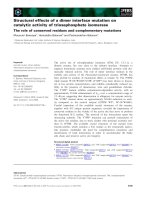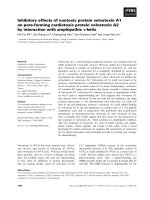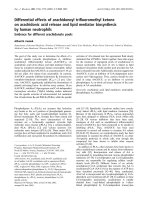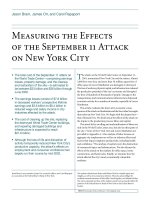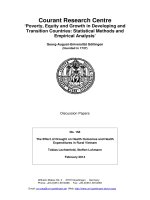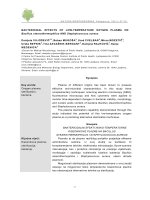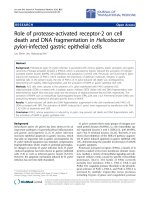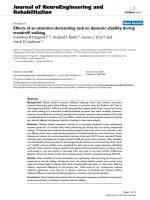Effects of bio probiotic betel bokashi on raising pigs and preventing diarrhea in young piglets in central vietnam
Bạn đang xem bản rút gọn của tài liệu. Xem và tải ngay bản đầy đủ của tài liệu tại đây (173.23 KB, 7 trang )
D
Journal of Agricultural Science and Technology A and B
& Hue University Journal of Science 7 (2017) 78-84
doi: 10.17265/2161-6256/2017.10.010S
DAVID
PUBLISHING
Effects of Bio-probiotic Betel Bokashi on Raising Pigs
and Preventing Diarrhea in Young Piglets in Central
Vietnam
Nguyen Quang Linh1 and Tran Thi Thiem2
1. Department of Nutritional Diseases and Systems for Livestock and Aquaculture, Institute of Biotechnology, Hue University, Hue
City 53000, Vietnam
2. Department of Agriculture and Rural Development, Tam Ky City 56000, Quang Nam Province, Vietnam
Abstract: Infection of Escherichia coli in piglets is identified as one of major problems in pig husbandry. Data were collected from
different experiments conducted at farm levels and results showed that the percentage of piglets infected with E. coli was very high.
E. coli infected healthy piglets were up to 48.9% and E. coli infected diarrhea piglets accounted for 88.3%. Using Betel Bokashi and
antibiotics in treatment brings about different results. Out of 48 infected piglets, 15 piglets were selected for three groups treatment
with five each group. Results showed that 92.3% diarrhea piglets treated with Betel Bokashi recovered in 3.85 d, while 100% and
88.23% treated with antibiotics were cured in 4 d and 4.01 d, respectively. Post-treatment piglets in group 3 grew up faster than
group 1 and group 2, with gains 231, 218 and 212 g, respectively.
Key words: Piglets, Escherichia coli, diarrhea, Betel Bokashi, health and treatment.
1. Introduction
Escherichia coli infection in piglets is identified as
one of major problems in pig husbandry. The major
serotypes causing the problems as usual include: O140,
O147, O141, O139, O138, O117 and O115 as listed in
Vietnam practices [1]. According to Loi [2], E. coli is
permanently present in healthy pigs as well. In healthy
pigs, there is E. coli K88. When the number of E. coli
multiplies, which means that the environment in pig
intestines has been altered, it is suitable for the
development of poisonous E. coli. Because the strains
of E. coli can cause diarrhea, antibiotics have long
been considered the most effective way to prevent and
treat the disease [3-5]. Diarrhea is a worrisome
problem caused by E. coli and has been researched
extensively to produce effective medications [6, 7].
However, recently, using conventional antibiotics to
Corresponding author: Nguyen Quang Linh, associate
professor, research fields: nutritional diseases and systems for
livestock and aquaculture.
treat the disease proves to be not effective. Some
antibiotics are completely ineffective due to resistance
to antibiotics of the bacteria. The research on
replacing antibiotics in treating diarrhea by using
herbal medicines, such as “Betel Bokashi”, was
reported in Binh Dinh province [2, 6]. Betel Bokashi
is a naturally occurring herb that inhibits bacteria with
substances, such as eugenol, chavicol, estradiol and
some other phenolic compounds added into the dietary
composition of piglets [2, 8]. The research aimed to
evaluate the impact of Betel Bokashi as treatment of
diarrhea by E. coli and the dose used in pig farms for
minimizing the health risk for reproductive sows and
suckling piglets in comparison of antibiotics.
2. Materials and Methods
2.1 Experimental Design
Suckling piglets were selected from different litters
at one pig farm of 50 sows. Just only 10 sows had
farrow at duration of one week at each batch. These
Effects of Bio-probiotic Betel Bokashi on Raising Pigs and Preventing Diarrhea
in Young Piglets in Central Vietnam
sows had the same feeding and housing condition.
There were 54 young piglets with diarrhea from 124
young piglets born alive and raising on farm. There
were 18 young piglets in each trial catch for treatment
and three trials in each experiment using different
doses of Betel Bokashi for treatment (Table 1). Trials
were as follows:
Control group (T1): Norflocacine was applied with
the dose of 1 mL/5 kg body weight (according to the
manufacturer’s instructions);
T2: Enroflocacine was given after 12 h of birth with a
dose of 0.5 mL/piglet. When piglets were infected and
had diarrhea, the dose of 1 mL/5 kg of body weight was
added (according to the manufacturer’s instructions);
T3: Betel Bokashi was supplemented to the piglets
at first week postpartum with direct dose of 3
mL/piglet by oral and 5-8 mL/d of Betel Bokashi was
supplemented to piglets at the 2nd week for 3-5
consecutive days.
2.2 Sample Analysis
Fecal samples of suckling pigs having diarrhea
were collected at farm and stored at freezer condition
agar, etc.. Chemicals used in the experiments are:
alcohol gram dyes, gentian violet, lugol and fuchsin.
Ten bacteria samples were randomly isolated from the
total numbers to determine the biochemical
characteristics of the bacteria. Pure monoculture was
kept for the identification of some biochemical
properties in the following environment: citrate,
Kligler’s iron agar (KIA), motility indol urease (MIU),
methyl red, glucose, saccharose and lactose.
Biochemical reagents were used for sugar
fermentation reaction and reading on the Petri was by
microscopy. The experimental factor is Betel Bokashi
to compare the differences between T1 (Norfloxacine),
T2 (Enrofloxacine) and T3 (Betel Bokashi) under
treatment regimens.
The experimental data were processed according to
the biostatistical method. All collected data was
managed using Microsoft Excel 2013 software and
analyzed statistically using Minitab software. Data
were presented as mean ± standard error of the mean.
Monitoring indicators include infection rate of E. coli,
cure rate, disease rate and weight gain, and they were
calculated by the following Eqs. (1)-(4):
of -20 °C until analysis. All the equipment and
materials as sterilized chambers, ovens, freezers and
79
Infection rate of E. coli (%) =
positive samples
× 100% (1)
isolated samples
autoclaves were used. Microscopes, culture incubator,
peptri plates, test tubes, alcohol lamps, triangles,
measuring cups, electronic scales, glass slides,
Cure rate ( % ) =
healthy piglets
× 100% (2)
infected piglets
syringes and other utensils were used in all of
protocols and analysis of samples.
All stool samples were transferred to the laboratory
Disease rate ( % ) =
infected piglets
× 100% (3)
piglets born alive
in warm cabinets at 37 °C for 24 h after that cultured
in an EMB agar medium where E. coli produced
purple iridescent colonies. All bacteria are stained
Mortality rate ( % ) =
dead piglets
× 100% (4)
piglets born alive
grams and isolates are sprouting, appearing pink and
reading the results.
3. Results and Discussion
2.3 Environment, Solution and Chemicals
3.1 Morphological and Biochemical Characteristic of
E. coli Strains
Types of media that transport, culture, isolate and
reading screen E. coli bacteria include common and
specific environments as common jelly, EMB, blood
Recognization via the morphological and culture
characteristics of E. coli strains isolated in this study
Effects of Bio-probiotic Betel Bokashi on Raising Pigs and Preventing Diarrhea
in Young Piglets in Central Vietnam
80
Table 1
Experimental setting-up.
Criteria
Piglets per batch
Replicates
Total
Fig. 1
Group 1
18
3
54
Group 2
18
3
54
Group 3
18
3
54
E. coli on EMB environment.
showed common typical characteristics of E. coli as
documented and published by other authors and
reference.
After incubation at 37 °C for 18-24 h, the following
results were obtained. The color of the medium did
not change in citrate tubes, suggesting that the bacteria
were not capable of using a negative citrate source. In
the KIA environment test tube, there was the
possibility of sugar fermentation. The stain at the
bottom of the test tube disappeared, pushing the agar
off the bottom, and no black sign at the bottom of the
tube indicated that the isolated bacteria were capable
of producing. In the test tube containing the MUI
environment, the bacteria were observed to grow
around the implants indicating that the bacteria were
mobile. After 4-5 drops of Kovac’s reagent was added,
a red ring appeared on the testicle. It was caused by
bacteria capable of forming tryptophan in the indol
environment. After the reagent was added, indole
combined
with
the
paradigm
ethylamino
benzaldehyde contained in the reagent to form a red
compound called rosindol, so that on the contact
surface, there was a dark red ring. In the methyl red
reaction, 2-3 d after incubation in a warm incubator,
2-3 drops of methyl red reagent were added. It was
observed that the medium turned red, indicating that
the bacteria had a positive methyl red response. The
usual environment was peptone glucose. This reaction
was used to distinguish E. coli from Enterobacter
aerogenes. E. aerogenes fermented glucose into
pyruvic acid and continued to metabolize acetyl
methyl carbonyl neutral, then the pH reached at 5.4.
The methyl blue changing into the red is negative
reaction on medium (Fig. 1).
E. coli also fermented glucose to pyruvic acid and
further converted acid to ethanol, acetic acid, H2, CO2,
lactic acid and succinic acid, making the pH of the
medium lower to 4.5 or lower. When small red methyl
was added, the medium turned red, so the methyl red
response was positive. In the fermentation of sugar
glucose, saccharose and lactose, the environment
turned from red to yellow. Because the medium
contained phenol red indicator, it was red at alkaline
pH and turned yellow at acidic pH. Bacterial isolates
were capable of using this sugar. Fermentation of
acids should lower the pH of the medium and alter the
Effects of Bio-probiotic Betel Bokashi on Raising Pigs and Preventing Diarrhea
in Young Piglets in Central Vietnam
color of the indicator.
From Table 2, it was shown that all bacteria were
tested by biochemical reactions with differences and
isolated for different types of E. coli, as described in
other publications [2, 9-11].
3.2 Test Results at Farm Level
According to the results collected during the
experiments, it was clear that the rate of young piglets
having diarrhea was very high, almost all piglets had
the disease at least once. The diarrhea situation of the
camp is presented in Table 3.
It was shown that the incidence of diarrhea in pigs
was 48.9%. In the first treatment T1 due to postnatal
disease, the diarrhea rate was higher than the other
two (T2 and T3). In T3, Betel Bokashi was used to
prevent piglets from diarrhea after birth, so the
incidence of diarrhea in this batch was the lowest.
This proves that the use of Betel Bokashi to prevent
bacterial diarrhea in piglets was more effective and
safe for pigs.
3.2.1 Rate of Samples Positive for E. coli
All samples were collected for laboratory testing to
determine the prevalence of E. coli infection
throughout the herd. After that, E. coli bacteria were
isolated according to the guidelines of the laboratories
the Department of Microbiology Infectious Diseases,
Department of Animal Husbandry, University of
Agriculture and Forestry, Hue University. All samples
were taken at the pig farm and results of isolation are
Table 2
Variables
n
Results
presented in Table 4.
The isolates showed that the number of samples
positive for E. coli in young piglets was quite high at
83.33%. Thus, the rate of E. coli isolation was present
in the piglets’ manure, which matched the findings in
Refs. [2, 12, 13] who reported that 100% healthy pigs’
isolates have E. coli, while a lower percentage has
other bacteria, Salmonelle and Staphylococcus. It was
shown in Table 4 that in the first block because of no
pre-diarrhea prevention, the number of samples
positive for E. coli was higher than the other two. In
both plots 2 and 3, E. coli was found to be 3.4% and
6.7%, respectively. It is found that if there is
prevention of diarrhea for pigs with antibiotics or
Betel bokashi, the result would be better than the
control.
3.2.2 Results after Treatment
The results of treatment using antibiotics and Betel
Bokashi proved to be both highly effective.
Specifically in T1 with norfloxacine, the number of
piglets cured was 15/17 piglets, the cure rate was
88.23% and the mortality rate was 6.67%. In T2 using
enrofloxacine, the number of piglets cured was 14/14,
the cure rate was 100% and no piglets died during
treatment. In T3 treatment using Betel Bokashi, the
number of cured piglets was 12/13, the cure rate was
92.3% and the mortality rate was 3.33%. From Table
4, it can be seen that in T2, when using enrofloxacine
for diarrhea treatment, all treated pigs became healthy
and none of them died. In T1 with norflocacine and T3
Biochemistry results of E. coli.
Citrate
-
Glucose
10
+
Lactose
10
+
Saccharose Air occurred
10
10
+
+
H2S
-
Moving
10
+
Urea
-
Indol
10
+
+: positive; -: negative.
Table 3
Trials
T1
T2
T3
Total
81
Situation of diarrhea in pig farms and number of infected piglets.
Litters (n)
3
3
3
9
No. of piglets (n)
30
30
30
90
No. of piglets infected (n)
17
14
13
44
Diarrhea (%)
56.7
46.7
43.3
48.9
MR
10
+
Effects of Bio-probiotic Betel Bokashi on Raising Pigs and Preventing Diarrhea
in Young Piglets in Central Vietnam
82
Table 4
Trials
T1
T2
T3
Total
Table 5
Trial
T1
T2
T3
Total
a-c
E. coli infection in piglets and litters.
Samples (n)
30
30
30
90
Infected samples (n)
26
25
24
75
Infected percentage/head (%)
86.7
83.3
80.0
83.33
Average percentage of healthy piglets after the treatments.
Infected rate (%)
56.67
46.67
43.33
48.89
Healthy rate (%)
88.23
100
92.3
88.74
No. of treatment days
4.01 ± 0.75a
4.00 ± 0.68b
3.85 ± 0.69c
3.97 ± 0.69
P
0.26
Means in the same column with different letters are of significant difference (P < 0.05).
with Betel Bokashi, the mortality rates were higher than
that of T2, but negligible. Of the three drugs used, the
cure rate for all three drugs was all higher than 85%.
Specifically, the cure rate with enrofloxacine was the
lowest, but also reached 85.7%. Especially when
using Betel Bokashi which was proved to be more
effective, the recovery rate was higher at 92.3%.
Duration of treatment is also a measure of
effectiveness of the drugs used; the shorter the
treatment time, the more effective the drug. Duration
of treatment is counted from the beginning of
treatment to the complete removal of the disease when
no symptoms existed. Table 5 is presented to provide
a specific number of treatment days for each batch.
Based on the results obtained from Table 5, it can
be found that the treatment days of the three
treatments varied from 3.85 d to 4 d, and there was no
statistically significant difference (P > 0.05). The rate
of disease was 56.67% in T1, 46.67% in T2 and
43.33% in T3, respectively.
Table 5 also shows that the duration of treatment
for diarrhea of the young piglets’ diarrhea at the farm
was relatively long with a median number of days of
treatment up to 3.97 d. The duration of treatment of
diarrhea using antibiotics or Betel Bokashi in camps
were the same, 4.01 d in T1, 4 d in T2 and 3.85 d in T3,
respectively (P > 0.05). It can be concluded that the
addition of Betel Bokashi for the treatment proved to
be more effective than antibiotics enrofloxacine or
norfloxacine.
The organs in the body of piglets in the period from
birth to weaning are not yet complete. Gastrointestinal
pepsin with the ability to slow the secretion is not
digested, so it is easy to be infected by gastrointestinal
tract. Piglets’ ability to regulate body temperature is
poor due to thin layers of fat under the skin. Piglets
are then easily affected by factors, such as temperature
and humidity. At this time, the piglets had an immune
system for resistance to diseases. At first, piglets’
immune system is passive, completely dependent on
the amount of antibody received from the mother pigs
through milk. Climate factors, weather conditions,
housing conditions, techniques, care and feeding are
also factors that cause bacterial diarrhea. In order to
treat bacterial diarrhea in pigs, it is necessary to
identify an effective antibiotic or herb that inhibits or
destroys the pathogen and enhances resistance of the
body. Currently, according to the study results of
many authors, many types of antibiotics have become
completely resistant to bacteria and no longer work in
disease prevention. According to Thuy and Phu [11], E.
coli isolated from white feces showed that 40% of E.
coli were resistant to streptomycin, 50% resistant to
sulphamid and 12% resistant to chlotetracyclin.
Therefore, bio-preparations should be used to treat
diarrhea instead of antibiotics so as to reduce the risk of
drug resistance.
Betel Bokashi was used to treat the 13 infected
Effects of Bio-probiotic Betel Bokashi on Raising Pigs and Preventing Diarrhea
in Young Piglets in Central Vietnam
piglets in T3. On the first day using Betel Bokashi, the
piglets’ feces were still loose, fur was still ruffled and
pigs were still moody, traveled less. However, on the
second day, the pigs were more agile and the stools
became more solid. On the third day, the pigs ate and
drank as normal, and could concentrate better.
The piglets’ feces on day 4 had clearly visible
shapes, forming stools. It also depended on the ability
of each piglet to absorb drugs, as observed, there were
some piglets that recovered on day 4 or 5, while there
were also some piglets that recovered on day 3.
The experiment was given a relative distribution of
neonatal birth weight between the experimental plots.
However, the weaning weight at 21 d of age and the
probability of gaining grams per head per day varied
between the following groups. The piglets in T2 were
supplemented with antibiotics to prevent diarrhea and
the control weaning weight varied from 6.08 kg/head
to 6.25 kg/head, corresponding to an average weight
gain of 212-220 g/head/day. Meanwhile, in T3, the
piglets were supplemented with Betel Bokashi,
average weaning weight was 6.76 kg/head and
average gain of 231 g/head/day. Thus, it can be seen
that in the three treatments on weaned piglets,
weaning weights were similar and the weight gain per
gram per day was similar. However, when
supplemented with Betel Bokashi to prevent diarrhea
caused by E. coli, piglets’ weaning weight was higher
than that of the other two groups. The treatment of
antibiotic to piglets of T2 and Betel Bokashi for T3
made the differences of growing (6.08-6.25 kg/head at
weaning and average weight gain of 212-218
g/head/day) as shown in Table 6. It can be found that
piglets treated using antibiotics after weaning grew
slower than that using Betel Bokashi. According to the
83
study by Trung [4], the addition of 2% of Achyranthes
aspera L. to pigs’ feeds during the second month of
pregnancy and during pregnancy, the resistance to
diarrhea would be enhanced for young piglets and
the mortality rate was reduced (9%); weaning weight
was very high (8.46 kg), but weaning time was 45 d
old. Based on the above results, it can be concluded
that the supplementation of Betel Bokashi for suckling
piglets results in a higher average weight per day gain
as compared to supplementation of antibiotic in
prevention and treatment of diarrheal disease in
piglets caused by E. coli in suckling piglets.
Table 7 showed that the infected percentages
between different treatments were not significantly;
when piglets having an addition of Betel Bokashi
showed a better than the treatment of Norflocacine
(T1), but was not better than Enroflocacine used (T2),
as according to the study of Phuong et al. [7], in which
they also use freeze-dried Biotactyl for piglets.
However, the rate of dead piglets are different
between antibiotics applied and Betel Bokashi used (P
< 0.05).
4. Conclusions and Recommendation
The percentage of E. coli positive specimens
isolated from fecal samples of mother pig infected
with diarrhea was 82.23%. All isolates carry the full
biochemical characteristics of E. coli.
The prevalence of diarrhea in the camp was high at
48.9%, and the average number of days of treatment
of diarrhea with Betel Bokashi was 3.85 d. Weight of
pigs after 21 d of age using Betel Bookish was 6.26 kg
and average weight gain was 221 g/head/day. When
using betel Bookish to prevent diarrhea on piglets,
there was no statistically significant difference.
Table 6 Growth of piglets on experimemt.
Trial
N
T1
T2
T3
3
3
3
a-c
Piglets
(n)
30
30
30
Everage weight
at birth
1.62 ± 0.11
1.61 ± 0.13
1.62 ± 0.17
Everage weight at weaning
P
6.08 ± 0.17b
6.25 ± 0.21b
6.86 ± 0.38a
0.016
Means in the same column with different letters are of significant difference (P < 0.05).
ADG
(g)
212 ± 10b
218 ± 10b
231 ± 14a
P
0.004
Effects of Bio-probiotic Betel Bokashi on Raising Pigs and Preventing Diarrhea
in Young Piglets in Central Vietnam
84
Table 7 Percentage of piglets recovering health.
Trials
T1
T2
T3
Total
a-c
No. of
Piglets
90
90
90
90
No of Infected
piglets (n)
48
48
48
48
Infected
percentage (%)
56.67
46.67
43.33
48.89
No. treatment
piglets (n)
15
15
15
39
P
0.56
Percentage of
piglets (%)
88.23
100
92.3
88.74
Percentage of dead
piglets (%)
6.67
0
3.33
3.33
Means in the same column with different letters are of significant difference (P < 0.05).
Through the results of this study, it can be
concluded that the use of Betel Bokashi as probiotics
resulted a higher than antibiotics, and that the use of
Betel Bokashi orally is more effective as compared
with other applications in the traditional using, but it
needs more time for labour.
[7]
[8]
[9]
References
[1]
[2]
[3]
[4]
[5]
[6]
Noi, N. T. 1986. “The Role of E. coli in Young Piglets’
Diarrhea and Vaccination for Prevention.” Ph.D. thesis,
Vietnam Institute of Agricultural Science and Technology.
Loi, D. T. 2004. Medicinal Plants and Medicaments of
Vietnam. Hanoi: Medical Publishing House, 118-9.
Thanh, N. N., and Chuong, P. Q. 2006. Booklet: Practical
Method of Veterinary Microbiology. Hanoi, Vietnam:
Agricultural Publishing House.
Trung, P. Q. 2008. “Influence of the Use of Achyranthes
aspera L., for Treating Diarrhea of Piglets during Breast
Meal by Supplementing into the Diets of Pregnant Sows.”
Hue University Journal of Science: Agriculture and Rural
Development 46: 148-55.
Tuyen, T. Q., Phuc, N. N., and Tao, L. V. 2004.
“Isolation and Identification of Pathogens of E. coli from
Diarrhea Pigs in Tam Diep.” Journal of Veterinary
Science and Technology 4: 22-8.
Nguyen, L. Q., Duyet, H. N., Vui, T. Q., and Hang, D.
T. 2014. “Piglet Diarrhea and Technology Transfers to
Prevent E. coli Infection at Small-Holder Pig Farms in
[10]
[11]
[12]
[13]
Binh Dinh, Vietnam.” J. Agri. Sci. Tech. B 4: 696-705.
Phuong, P. T., Khanh, N. T., and Thanh, T. K. 1981.
“Effect of Pig Intestinal Flora Prevention of Freeze-Dried
Biolactyl in Pigs.” Journal of Agricultural Science and
Technology 2: 159-60.
Linh, N. Q. 2005. Swine Technical Textbook. Hanoi,
Vietnam: Agricultural Publishing House, 121-2.
Phu, C. H., Nhien, N. N., Minh, V. B., and Thuy, D. N.
2000. “Isolation of E. coli and Samonella in Piglets with
Diarrhea, Identification of Some Biochemical
Characteristics of Isolated Strains and Preventive
Measures.” In Results of Veterinary Science and
Technology Research 1996-2000. Hanoi: Hanoi
Publishing House, 171-6.
Phu, C. H., Nhien, N. N., Thuy, D. N., Huyen, N. X.,
Tuan, A. X., Huong, V. T., and Hao, D. T. 2004.
“Determination of Antibiotic Resistance Rates and
Pathogens of Isolates of E. coli in Northern Pig Farms in
Vietnam.” Vietnam Journal of Veterinary Science and
Technology 6: 122-30.
Thuy, D. N., and Phu, C. H. 2002. “Resistance of E. coli
Strains Isolated from Piglets of Diarrhea in Northern
Provinces of Vietnam.” Vietnam Journal of Veterinary
Science and Technology 2: 244-51.
Vinh, T. T. 1996. “Gastrointestinal Pathological Changes
in Piglets’ White Diarrhea.” Ph.D. thesis, Hanoi
University of Agriculture.
Lior, H. 1996. “Classification of Eschecheria coli.” In E.
coli in Domestic Animals and Humans, edited by Gyles,
C. L. Wallingford: CAB International, 31-72.

